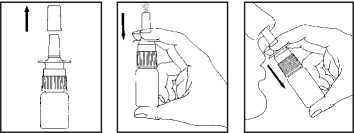Rhinolast Nasal Spray
Out of date information, search anotherRHINOLAST® NASAL SPRAY/AZELASTINE NASAL SPRAY
(azelastine hydrochloride)
Patient Information Leaflet
Your medicine is available using either of the above names but will be referred to as Rhinolast throughout this leaflet.
Read all of this leaflet carefully before you start using this medicine.
- Keep this leaflet. You may need to read it again.
- If you have any further questions, ask your doctor or pharmacist.
- This medicine has been prescribed for you. Do not pass it on to others. It may harm them, even if their symptoms are the same as yours.
In this leaflet:
1. What Rhinolast is for 4. Possible side effects
2. Before you use Rhinolast 5. How to store Rhinolast
3. How to use Rhinolast 6. Further information
1. WHAT RHINOLAST IS FOR
Rhinolast belongs to a group of medicines called antihistamines. These work by preventing the effects of histamine that the body produces as part of an allergic reaction.
Rhinolast is used to treat allergic rhinitis. This is an allergy which may affect you only at certain times of the year (for example, allergy to pollen, called hayfever), or all year round (for example, allergy to the house dust mite or dog and cat hairs).
Usually it affects you by causing a runny nose, sneezing, itching or blocked nose. Rhinolast should help control these symptoms.
This product may be used by adults and children aged 6 years and older.
2. BEFORE YOU USE RHINOLAST Do not use Rhinolast if:
• You are allergic to azelastine hydrochloride or any of the other ingredients of Rhinolast (listed in Section 6). If this applies to you, talk to your doctor or pharmacist.
Pregnancy and breast-feeding
If you are pregnant, trying to become pregnant or are breast-feeding ask your doctor or pharmacist for advice before using Rhinolast.
3. HOW TO USE RHINOLAST
Always use the spray exactly as your doctor has told you.
Important:
Your doctor will choose the dose that is right for you. Your dose will be shown clearly on the label that your pharmacist puts on your medicine. If it does not, or you are not sure, ask your doctor or pharmacist.
Adults and children aged 6 years and over.
How much to use
• The usual dose is one squirt into each nostril in the morning and then again in the evening.
How to use the spray
1. Blow your nose first
2. Remove the protective cap (Diagram 1)
3. Before the first use, press the pump several times until an even spray emerges (Diagram 2)
4. Spray once into each nostril keeping head upright. Do not tilt head backwards (Diagram 3)
5. Wipe the pump nozzle and replace the protective cap.

Diagram 1 Diagram 2
Diagram 3
If you use more Rhinolast than you should
If you spray too much Rhinolast into your nose you are unlikely to have any problems.
Contact your doctor if you are worried.
If anyone, especially a child, accidentally drinks Rhinolast, contact your doctor or local hospital casualty department immediately.
If you accidentally get Rhinolast in your eyes, bathe them with plenty of water. They may sting for a while. If you forget to use Rhinolast
Use the spray as soon as you remember, then take the next dose at the usual time. Do not take a double dose to make up for a missed dose.
If you have any other questions about using this medicine, ask your doctor or pharmacist.
r '
4. POSSIBLE SIDE EFFECTS
Like all medicines Rhinolast can cause side effects, although not everybody gets them.
These effects include:
Common (1 to 10 of 100 patients treated) An unpleasant taste in your mouth especially if you tilt your head backwards when you are using the nasal spray. In rare cases the unpleasant taste may cause you to feel sick.
Uncommon (1 to 10 of 1,000 patients treated) Slight irritation of the inside of the nose (stinging, itching) sneezing and epistaxis.
Very rare (less than 1 of 10,000 patients treated) Hypersensitivity reactions (such as rash, pruritus, urticaria).
Reporting of side effects
If you get any side effects, talk to your doctor, pharmacist or nurse. This includes any possible side effects not listed in this leaflet. You can also report side effects directly via the Yellow Card Scheme at: www.mhra.gov.uk/yellowcard
By reporting side effects you can help provide more information on the safety of this medicine.
5. HOW TO STORE RHINOLAST
• Rhinolast nasal spray/Azelastine nasal spray should not be stored below 8°C. Do not refrigerate.
• KEEP ALL MEDICINES OUT OF THE SIGHT AND REACH OF CHILDREN.
• If your doctor tells you to stop using the spray, please take it back to the pharmacist for safe disposal. Only keep the spray if your doctor tells you to.
• If the spray becomes discoloured or shows sign of any deterioration, you should seek the advice of your pharmacist who will advise you what to do.
• Medicines should not be disposed of via wastewater or household waste. Return any medicine you no longer need to your pharmacist.
6. FURTHER INFORMATION
Your medicine is called Rhinolast nasal spray/Azelastine nasal spray. It contains a solution of 0.1% of the active ingredient, azelastine hydrochloride. Each squirt of spray contains 0.14mg azelastine hydrochloride in a clear solution.
Rhinolast nasal spray/Azelastine nasal spray also contains the following:
hypromellose, disodium edetate, anhydrous citric acid, sodium chloride, sodium phosphate and purified water.
Rhinolast nasal spray/Azelastine nasal spray is available as a glass bottle containing 20ml of nasal spray solution.
POM PL No: 6464/0685
This product is manufactured by MEDA Pharma GmbH & Co KG, Bad Homburg, Germany and is procured from within the EU and repackaged by the Product Licence holder:
Waymade plc, Miles Gray Road, Basildon, Essex, SS14 3FR.
Leaflet revision and issue date (Ref.) 28.05.2014
Rhinolast is a registered trademark of MEDA Pharma GmbH & Co KG
V